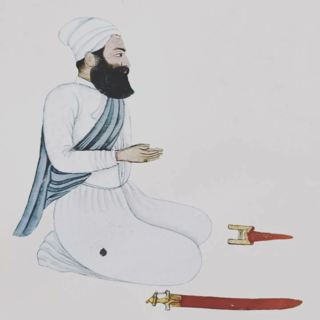
Bhai Mani Singh was an 18th-century Sikh scholar and martyr. He was a childhood companion of Guru Gobind Singh and took the vows of Sikhism when the Guru inaugurated the Khalsa in March 1699. Soon after that, the Guru sent him to Amritsar to take charge of Harmandir Sahib, which had been without a custodian since 1696. He took control and steered the course of Sikh destiny at a critical stage in Sikh history. He was also a teacher of the Gianian Bunga, later becoming known as the "Amritsari Taksal", currently located in Sato Ki Gali.

Mata Gujri, also spelt as Mata Gujari, was the wife of Guru Tegh Bahadur, the ninth Guru of Sikhism, and the mother of Guru Gobind Singh, the tenth Guru of Sikhism. She played a central role in the history of Sikhism and is one of the four consorts bestowed with the title of Guru-Mahal.

Hola Mohalla, also called Hola, is a three-day long Sikh festival which normally falls in March. It takes place on the second day of the lunar month of Chett, usually a day after the Hindu spring festival Holi, but sometimes coincides with it. Hola Mohalla is a big festive event for Sikhs around the world.

Bhai Dayala, died 9 November 1675, also known as Bhai Dayal Das, was an early martyr of Sikhism. He was boiled alongside his Sikh companions Bhai Mati Das and Bhai Sati Das and the Ninth Guru, Guru Tegh Bahadur.

Bhai Sati Das along with his elder brother Bhai Mati Das were martyrs of early Sikh history. Bhai Sati Das, Bhai Mati Das and Bhai Dyal Das were all executed at kotwali (police-station) in the Chandni Chowk area of Delhi, under the express orders of emperor Aurangzeb just prior to the martyrdom of Guru Tegh Bahadur. Bhai Sati Das was executed by the means of being wrapped in cotton wool soaked in oil and set on fire.
The Battle of Bhangani was fought between Guru Gobind Singh's army and Bhim Chand (Kahlur) of Bilaspur on 18 September 1686 or 1688, at Bhangani near Paonta Sahib. An alliance of Rajput Rajas of the Shivalik Hills participated in the engagement on behalf of Bhim Chand of Bilaspur State's side, including the states of Garhwal and Kangra. It was the first battle Guru Gobind Singh, the tenth Sikh Guru, fought at the age of 19.
The Battle of Anandpur was fought at Anandpur, between the armies of the Sikh Guru Gobind Singh and the Mughal forces aided by the Nawab of Bahawalpur state, Rajas of the Sivalik Hills.

The second siege of Anandpur, also known as the second battle of Anandpur (1704), was a siege at Anandpur, between Sikhs and the Mughal governors, dispatched by Aurangzeb, Wazir Khan, Dilwaar Kahn and Zaberdast Khan, and aided by the vassal Rajas of the Sivalik Hills which lasted from May 1704 to 19 December 1704.

The Saka Sirhindor the Chhotte Sahibzada Saka refers to the killing and martyrdom (Shaheedi) of the two sons of Guru Gobind Singh, named Zorawar Singh and Fateh Singh. The two Sikh children are remembered as the Chhotte Sahibzade. They are believed to have attained martyrdom on 26 December 1704 at the ages of 5(or 6) and 9 respectively. In remembrance of this occasion, the Shaheedi Jor Mela is organised annually at Fatehgarh Sahib Punjab, India, to commemorate the supreme sacrifice at the place of their martyrdom on the 24th to 26 December.

Baba Jiwan Singh was a Sikh general and companion of Guru Gobind Singh.

Bhai Nihang Khan was the zamindar ruler of a small feudal estate called Kotla Nihang Khan near Ropar in Punjab, Lahore Subah, Mughal Empire. He was a friend and follower of the tenth Sikh Guru, Guru Gobind Singh. The Guru and his associates frequently stayed with Nihang Khan, who often sheltered and provided succor to them in the period when they were facing persecution by Mughal forces. By way of faith and ethnicity, Nihang Khan was a Muslim Pathan.
The Battle of Basoli was fought between the Mughal Empire and the Sikhs.
The first siege of Anandpur was a thirty-five-day-long siege at Anandpur led by the Rajas of the Sivalik Hills and the Gujar and Ranghar tribesmen against the armies of the Sikh under Guru Gobind Singh.
The Battle of Taragarh was fought between the Sikh forces led by Sahibzada Ajit Singh and the Rajas of the Sivalik Hills.

The Hill States–Sikh wars, also known as the Sikh–Pahari Raja wars, was a set of battles and conflicts fought by the Sikhs and the rajas (kings) of the Hill States located in the Sivalik Hills.
The Battle of Anandpur was fought between the Sikh forces led by Guru Gobind Singh and the Hill State forces by Alim and Balia Chand. This was the first major battle fought after the formation of the Khalsa.

Alam Singh Nachna, also called Alim Singh, was a warrior in the army of Guru Gobind Singh, and was a Rajput turned Sikh. Sarup Das Bhalla of Mahima Prakash describes him as one of Guru Gobind Singh's constant and closest companions. He is also known for killing a lion single handedly.
Uday Singh was a Sikh warrior during the period of Guru Gobind Singh.










